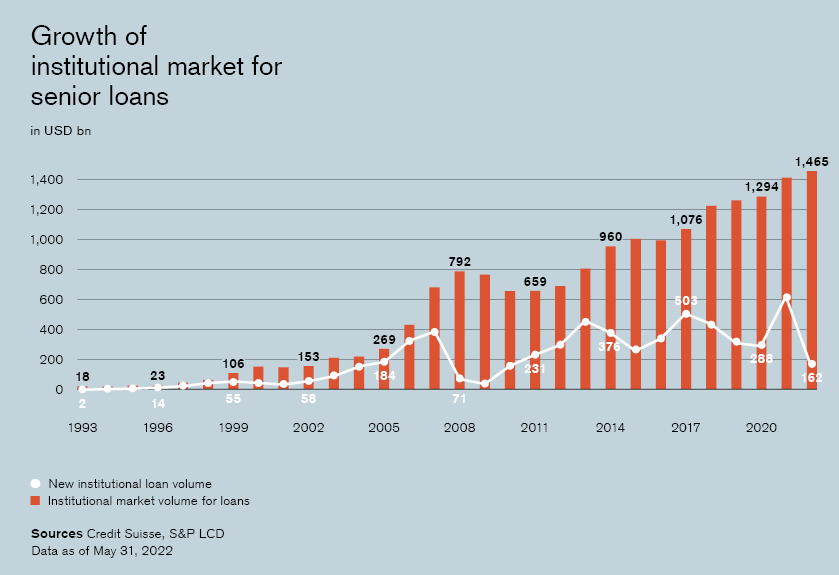Article
Why senior secured loans are loved by bond investors
This is not an asset class that all bond investors are familiar with. But it is an important one because it could become crucial in the fight against inflation.
July 21, 2022

Article
This is not an asset class that all bond investors are familiar with. But it is an important one because it could become crucial in the fight against inflation.
July 21, 2022

For more than a decade, the investment environment for bonds has been nothing short of weird. We have lived through 14 years of insanely low interest rates and the longest credit cycle in financial history. The risk landscape has been transformed and distorted, forcing bond investors to completely rethink how they look at bond risk.
Now there is another seismic shift underway, brought about by the end of the pandemic. We are experiencing the highest levels of headline inflation in 40 years. Central banks are consequently planning to start a cycle of interest rate increases – an event that has not taken place since before the Great Financial Crisis in 2008.
For bond investors, this headache could turn into a migraine. Hopefully, senior secured loans could be part of the cure.
Senior loans are investments rated below investment grade. These investments are speculative in nature and are considered to have a high degree of investment risk. Such assets have greater default risks, greater exposure to market volatility and greater liquidity risks when compared to investment grade debt obligations.
We all know that traditionally banks make loans to businesses. In return, businesses secure those loans using inventory, property, equipment, and real estate. During the 1990s, banks started to increase their lending capabilities by syndicating these loans.
What this meant was that the bank was not the lender. The bank’s role was to arrange the structuring process and then find investors for these loans. These instruments became known as senior secured loans.
They trade like bonds in the secondary market, but there are some differences. While senior secured bonds pay fixed coupons, senior secured loans pay floating rate coupons, which are made up of a fixed spread over a moving reference interest rate. In the past this was LIBOR, which is rapidly being replaced by the Secured Overnight Financing Rate (SOFR).
The fixed spread on a senior secured loan is set by the syndicating bank based on feedback it receives from investors on what is a suitable rate. For investors, a suitable rate represents the credit risk they are willing to take, or the risk premium that they want to be rewarded for holding the senior secured loan. Typically, this is assessed by a seasoned credit analyst who will look at the health of the company’s earnings and its corporate outlook to assess how easily that business can service these loans without defaulting.
These are often the same analysts that study high yield bonds. This is because senior secured loans are usually issued by the same companies that issue high yield bonds.
It is true that senior secured loans are rated below investment grade by major credit agencies. However, this is often because the companies that issue them are highly leveraged on a relative basis. This can happen when the loan is being issued to finance an acquisition.
However, investors are compensated with a relatively attractive return versus other asset classes. This is also a fairly unique asset class, offering bond investors a very powerful strategic asset allocation tool during periods of market turbulence and inflation. That is why senior secured loans are loved by bond investors.
You need to remember that these are still loans, which makes them very different from bonds. Senior secured loans are secured by the assets of the borrower. Consequently, they have a more senior position in a company’s capital structure.
This means that as loan holders, investors in senior secured bonds are paid first if a company goes bankrupt. This has a huge positive impact on the credit risk, which is one of the attractions for investing in them. Furthermore, investors also benefit from higher recovery rates in the case of default because these bonds are secured by assets.
However, because senior secured loans are so different from other types of bonds in terms of their structure and covenants, their returns are less correlated to the rest of the bond universe, which is great for portfolio construction.
What senior secured loans offer is an alternative source of risk premium for bond investors. This can be particularly useful for portfolio construction. When added to a portfolio, they can help increase diversification and enhance the portfolio’s risk-return profile.
However, their most useful attribute is their ability to reduce duration risk. This is the risk associated with rising inflation and interest rates, which is the environment we are now entering. It means that bond investors can strategically use senior secured loans to fight the risk of inflation. These are instruments that will offer attractive income on a real basis, regardless of the inflation environment.

Senior loans date back to the late 1980s, when the market for high-yield bonds expanded in the US and institutional investors began to participate in the purchase of loans. Insurance companies and investment funds were among the first non-banks to become involved in the business.
This development continued with the increasing consolidation of the US banking sector in the 1990s. Indeed, in the aftermath of the global financial crisis, structured vehicles – primarily collateralized loan obligations – became an increasingly important component of demand. The growth of this asset class was primarily down to the increasing involvement of non-banks, investment funds, and above all pension funds.
Demand for the asset class among institutional investors has increased substantially with the ongoing development of research, trading, and pricing. The market for non-investment grade loans is currently estimated at USD 1.4 trillion, thus outstripping the market for high-yield bonds.
Broadly speaking, there are two sets of investors that buy senior secured loans. The first set are the issuers of collateralized loan obligations (CLOs), which make up about 60% of the market. These are special purpose vehicles that are set up to hold and manage pools of leveraged loans, to create a marketable security. This process is known as securitization. These CLOs can then be bought by other investors.
These investors are an important stabilizing force for the senior secured loan market. CLOs are lock-up structures, which means that they are less likely to sell during a correction, helping to lower market volatility.
The second set of investors, which are now growing in importance, are institutional investors such as high yield bond funds, hedge funds, pension funds, and insurance companies. These investors tend to be more strategic and hold senior secured loans as part of a long-term strategic asset allocation strategy. They too do not tend to move in and out of the market rapidly, which also helps lower market volatility.
These investors also hold secured loans because, as mentioned, they are very useful in fighting inflation. They help by lowering the overall duration risk of a portfolio and by providing a healthy yield that moves with interest rates.

To what extent and for how long will inflation rise? The uncertainty surrounding the effects of inflation has increased massively. The current situation is calling for existing investment strategies to be reviewed and new opportunities to be evaluated.
Contact us to learn about exciting investment opportunities. We are here to help you achieve your investment goals.

This material constitutes marketing material of Credit Suisse Group AG and/or its affiliates (hereafter "CS") and provides information on a strategy. This material does not constitute or form part of an offer or invitation to issue or sell, or of a solicitation of an offer to subscribe or buy, any securities or other financial instruments, or enter into any other financial transaction, nor does it constitute an inducement or incitement to participate in any product, offering or investment. This marketing material is not a contractually binding document or an information document required by any legislative provision. Nothing in this material constitutes investment research or investment advice and may not be relied upon. It is not tailored to your individual circumstances, or otherwise constitutes a personal recommendation, and is not sufficient to take an investment decision. The information and views expressed herein are those of CS at the time of writing and are subject to change at any time without notice. They are derived from sources believed to be reliable. CS provides no guarantee with regard to the content and completeness of the information and where legally possible does not accept any liability for losses that might arise from making use of the information. If nothing is indicated to the contrary, all figures are unaudited. The information provided herein is for the exclusive use of the recipient. The information provided in this material may change after the date of this material without notice and CS has no obligation to update the information. This material may contain information that is licensed and/or protected under intellectual property rights of the licensors and property right holders. Nothing in this material shall be construed to impose any liability on the licensors or property right holders. Unauthorised copying of the information of the licensors or property right holders is strictly prohibited. This material may not be forwarded or distributed to any other person and may not be reproduced. Any forwarding, distribution or reproduction is unauthorized and may result in a violation of the U.S. Securities Act of 1933, as amended (the “Securities Act”). In addition, there may be conflicts of interest with regards to the investment. In connection with the provision of services, Credit Suisse AG and/or its affiliates may pay third parties or receive from third parties, as part of their fee or otherwise, a one-time or recurring fee (e.g., issuing commissions, placement commissions or trailer fees). Prospective investors should independently and carefully assess (with their tax, legal and financial advisers) the specific risks described in available materials, and applicable legal, regulatory, credit, tax and accounting consequences prior to making any investment decision.
Copyright © 2022 CREDIT SUISSE. All rights reserved.